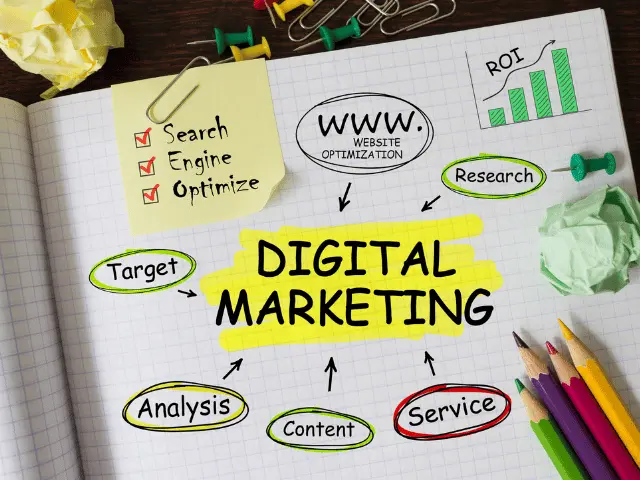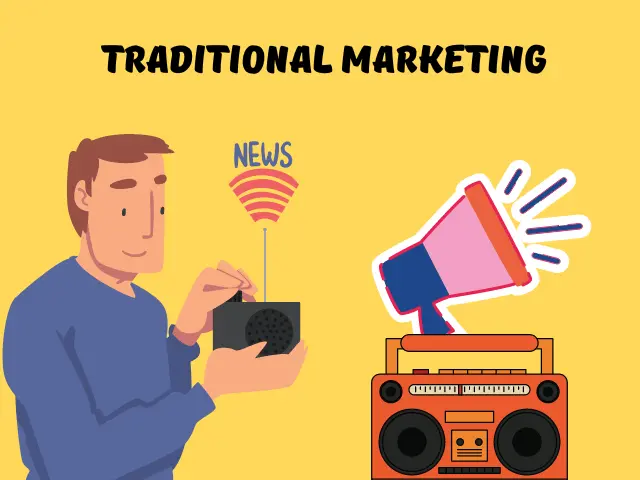Digital Marketing vs Traditional Marketing
Digital Marketing and Traditional Marketing are two distinct approaches for promoting products and services. While traditional marketing has been the long-standing method, digital marketing has emerged as a powerful alternative in the modern age.
What is digital marketing?

Digital marketing refers to promoting products, services, and brands using digital channels and technologies. It encompasses various online marketing strategies and tactics to reach and engage a target audience through digital platforms such as the Internet, mobile devices, social media, search engines, email, and more.
Digital marketing involves a range of activities, including:
1. Search Engine Optimization (SEO):
Optimizing websites and content to rank higher in search engine results, increasing visibility and organic traffic.
2. Search Engine Marketing (SEM):
Running paid advertisements on search engines like Google to drive targeted traffic to a website.
3. Social Media Marketing:
Leveraging social media platforms like Facebook, Instagram, Twitter, LinkedIn, and others to build brand awareness, engage with the audience, and drive traffic and conversions.
4. Content Marketing:
Creating and distributing valuable and relevant content (such as blog posts, articles, videos, and infographics) to attract and retain a target audience, ultimately driving profitable customer actions.
5. Email Marketing:
Sending targeted messages and promotional offers to a subscribed audience via email to nurture customer relationships and drive conversions.
6. Influencer Marketing:
Collaborating with influential individuals or personalities on social media to promote products or services to their followers and leverage their influence.
7. Affiliate Marketing:
Partnering with affiliates who promote products or services and earn a commission for each referral or sale they generate.
8. Online Advertising:
Displaying ads on various online platforms, including search engines, social media, websites, and mobile apps, to reach a specific audience and drive traffic and conversions.
9. Mobile Marketing:
Optimizing marketing efforts for mobile devices, including mobile-responsive websites, mobile apps, and mobile-specific advertising.
10. Data Analytics and Tracking:
Using tools and technologies to measure, analyze, and optimize marketing campaigns, gathering insights into user behavior, demographics, conversion rates, and other key performance indicators.
8 Advantages of Digital Marketing

Digital marketing offers numerous advantages over traditional marketing methods. Here are some key advantages of digital marketing:
1. Precise Audience Targeting:
Digital marketing allows for highly targeted and personalized campaigns. Marketers can reach specific audience segments based on demographics, interests, behavior, and other factors. This precision ensures that marketing messages are delivered to the right people, increasing the chances of engagement and conversion.
2. Cost-Effectiveness:
Digital marketing can be more cost-effective compared to traditional marketing channels. Online advertising, such as pay-per-click (PPC) ads, social media advertising, or email marketing, often provides flexible budget options and allows businesses to optimize spending based on performance. This makes digital marketing accessible to businesses of all sizes, including those with limited budgets.
3. Measurable Results:
One of the significant advantages of digital marketing is the ability to measure and track results accurately. Marketers can use various analytics tools to monitor key performance indicators (KPIs) such as website traffic, conversions, click-through rates, engagement levels, and more. This data provides insights into the effectiveness of campaigns and allows for data-driven decision-making and continuous optimization.
4. Real-Time Feedback and Adjustments:
Digital marketing provides immediate feedback and allows for real-time adjustments. Marketers can monitor campaign performance in real time, identify what is working and what isn’t, and make necessary adjustments on the fly. This agility enables businesses to optimize their marketing efforts, refine their messaging, and adapt to changing market dynamics quickly.
5. Global Reach:
With the internet connecting people worldwide, digital marketing allows businesses to reach a vast global audience. Geographic barriers are minimized, enabling companies to expand their market reach beyond local boundaries and target customers in different regions or countries. This opens up new growth opportunities and potential customer bases.
6. Interactivity and Engagement:
Digital marketing offers various interactive and engaging formats, such as social media posts, videos, quizzes, contests, live chats, and user-generated content. These formats foster direct communication and interaction with the target audience, enabling businesses to build relationships, gather feedback, and create a sense of community around their brand.
7. Flexibility and Campaign Optimization:
Digital marketing campaigns can be adjusted and optimized in real time based on performance data. Marketers can experiment with different strategies, test different messages or creative elements, and refine their campaigns to achieve better results. This flexibility allows for continuous improvement and maximization of ROI.
8. Integration and Personalization:
Digital marketing allows for seamless integration across different channels and platforms. Businesses can create consistent and cohesive brand experiences across websites, social media, email, and other digital touchpoints. Additionally, digital marketing enables personalized communication and customized experiences based on user preferences, enhancing customer engagement and satisfaction.
What is Traditional Marketing?

Traditional marketing refers to the conventional methods and channels used to promote products, services, and brands before the rise of digital technologies. It involves offline promotional activities that aim to reach a target audience through various traditional media channels.
Some common forms of traditional marketing include:
1. Print Advertising:
This includes advertisements placed in newspapers, magazines, brochures, flyers, and other printed materials. Print ads are distributed in physical form and can reach a wide audience.
2. Broadcast Advertising:
Traditional marketing utilizes television and radio to deliver advertising messages. Television commercials and radio spots are broadcast to viewers and listeners during designated time slots.
3. Outdoor Advertising:
Also known as out-of-home (OOH) advertising, this includes billboards, signage, posters, banners, and transit advertisements displayed in public spaces like roadsides, bus stops, train stations, and airports.
4. Direct Mail Marketing:
In direct mail marketing, physical promotional materials, such as letters, postcards, catalogs, or samples, are sent directly to the target audience’s mailbox.
5. Telemarketing:
Telemarketing involves reaching out to potential customers through telephone calls to promote products or services, gather information, or conduct market research.
6. Trade Shows and Events:
Traditional marketing often includes participation in trade shows, exhibitions, conferences, and other events where businesses can showcase their products or services and interact with potential customers face-to-face.
7. Public Relations (PR):
PR activities involve managing a company’s image and reputation through press releases, media coverage, press conferences, sponsorships, and community involvement.
4 Advantages of Traditional Marketing:

1. Tangibility:
Traditional marketing allows for physical presence, as printed materials and physical advertisements are tangible and can be directly interacted with by the audience.
2. Local Targeting:
Traditional marketing channels like local newspapers, radio stations, or community events can effectively target specific geographic areas or local communities.
3. Credibility:
Traditional media outlets such as reputable newspapers or television networks often carry a level of credibility and trust, which can enhance the perceived reliability and reputation of a brand.
4. Wide Audience Reach:
Traditional marketing methods have the potential to reach a broad audience, including those who may not have access to digital platforms or are less tech-savvy.
However, traditional marketing also has limitations compared to digital marketing, including higher costs, limited audience targeting capabilities, difficulties in measuring ROI accurately, and the lack of real-time feedback and interactivity. Businesses need to carefully evaluate their target audience, goals, budget, and the evolving marketing landscape to determine the appropriate mix of traditional and digital marketing strategies for their specific needs.
Ready to get started learning Digital Marketing? Register for a free demo
Get more details regarding Powerpoint
Phone no.
9988-500-936
Address
SCF 22, First floor, GTB Market, Khanna
Website
www.microwavecomputer.com
Opening Hours
08:30 am - 06:00 pm
